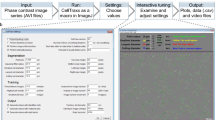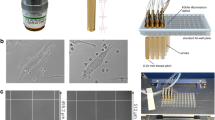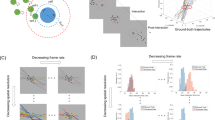Key Points
-
To analyse time-lapse video microscopy experiments of the immune system, quantification of cell migration is required. A toolbox of quantitative measures, such as cell speed, motility coefficient, confinement ratio and various angles of migration is available for that purpose.
-
Time-lapse imaging of the immune system is associated with various artefacts than can affect the estimated cell positions over time. As a result, measures of cell migration are also affected by such artefacts, and this may obscure biologically relevant differences between experimental settings or generate spurious results.
-
Imaging artefacts are related either to cell tracking (switching or splitting of tracks, double tracking of cells and errors of tracking near borders) or to imaging itself (imprecise calibration of the axial dimension and small tissue drift).
-
Detection and correction for artefacts can be done using various migration angles. For example, plotting the average angle to the axial border plane versus the distance to that border can help to detect border tracking errors, calibration errors in the axial dimension and small tissue drift.
-
Cell-based measurements are better at detecting distinct subpopulations among cells than step-based approaches. However, an important disadvantage of cell-based versus step-based parameters is that the shape of the imaged space affects the results, and this makes comparison between experiments problematic.
-
Determining contact times between cells in imaging experiments is non-trivial because observed (underestimated) rather than exact contact time is known for most contacts. However, the true contact time distribution can be estimated using a mathematical approach.
Abstract
The visualization of the dynamic behaviour of and interactions between immune cells using time-lapse video microscopy has an important role in modern immunology. To draw robust conclusions, quantification of such cell migration is required. However, imaging experiments are associated with various artefacts that can affect the estimated positions of the immune cells under analysis, which form the basis of any subsequent analysis. Here, we describe potential artefacts that could affect the interpretation of data sets on immune cell migration. We propose how these errors can be recognized and corrected, and suggest ways to prevent the data analysis itself leading to biased results.
This is a preview of subscription content, access via your institution
Access options
Subscribe to this journal
Receive 12 print issues and online access
$209.00 per year
only $17.42 per issue
Buy this article
- Purchase on Springer Link
- Instant access to full article PDF
Prices may be subject to local taxes which are calculated during checkout





Similar content being viewed by others
References
Bousso, P., Bhakta, N. R., Lewis, R. S. & Robey, E. Dynamics of thymocyte-stromal cell interactions visualized by two-photon microscopy. Science 296, 1876–1880 (2002).
Miller, M. J., Wei, S. H., Parker, I. & Cahalan, M. D. Two-photon imaging of lymphocyte motility and antigen response in intact lymph node. Science 296, 1869–1873 (2002).
Stoll, S., Delon, J., Brotz, T. N. & Germain, R. N. Dynamic imaging of T cell-dendritic cell interactions in lymph nodes. Science 296, 1873–1876 (2002).
Lindquist, R. L. et al. Visualizing dendritic cell networks in vivo. Nature Immunol. 5, 1243–1250 (2004).
Mempel, T. R., Henrickson, S. E. & von Andrian, U. H. T cell priming by dendritic cells in lymph nodes occurs in three distict phases. Nature 427, 154–159 (2004).
Allen, C. D., Okada, T., Tang, H. L. & Cyster, J. G. Imaging of germinal center selection events during affinity maturation. Science 315, 528–531 (2007).
Qi, H., Cannons, J. L., Klauschen, F., Schwartzberg, P. L. & Germain, R. N. SAP-controlled T–B cell interactions underlie germinal centre formation. Nature 455, 764–769 (2008).
Miller, M. J., Safrina, O., Parker, I. & Cahalan, M. D. Imaging the single cell dynamics of CD4+ T cell activation by dendritic cells in lymph nodes. J. Exp. Med. 200, 847–856 (2004).
Sumen, C., Mempel, T. R., Mazo, I. B. & von Andrian, U. H. Intravital microscopy: visualizing immunity in context. Immunity 21, 315–329 (2004).
Beauchemin, C., Dixit, N. M. & Perelson, A. S. Characterizing T cell movement within lymph nodes in the absence of antigen. J. Immunol. 178, 5505–5512 (2007).
le Borgne, M. et al. The impact of negative selection on thymocyte migration in the medulla. Nature Immunol. 10, 823–830 (2009).
Doi, M. & Edwards, S. F. The Theory of polymer Dynamics (Clarendon, Oxford, UK,1986).
Rubinstein, M. & Colby, R. H. Polymer Physics (Oxford Univ. Press, New York, 2003).
Wieser, S. & Schütz, G. J. Tracking single molecules in the live cell plasma membrane — do's and don't's. Methods 46, 131–140 (2008).
Beltman, J. B., Marée, A. F. M., Lynch, J. N., Miller, M. J. & de Boer, R. J. Lymph node topology dictates T cell migration behaviour. J. Exp. Med. 204, 771–780 (2007).
Benhamou, S. How to reliably estimate the tortuosity of an animal's path: straightness, sinuosity, or fractal dimension? J. Theor. Biol. 229, 209–220 (2004).
Bogle, G. & Dunbar, P. R. Simulating T-cell motility in the lymph node paracortex with a packed lattice geometry. Immunol. Cell Biol. 86, 676–687 (2008).
Mrass, P. et al. CD44 mediates successful interstitial navigation by killer T cells and enables efficient antitumor immunity. Immunity 29, 971–985 (2008).
Preston, S. P., Waters, S. L., Jensen, O. E., Heaton, P. R. & Pritchard, D. I. T-cell motility in the early stages of the immune response modeled as a random walk amongst targets. Phys. Rev. E Stat. Nonlin. Soft Matter Phys. 74, 011910 (2006).
Beltman, J. B., Marée, A. F. M. & de Boer, R. J. Spatial modelling of brief and long interactions between T cells and dendritic cells. Immunol. Cell Biol. 85, 306–314 (2007).
Castellino, F. et al. Chemokines enhance immunity by guiding naive CD8+ T cells to sites of CD4+ T cell-dendritic cell interaction. Nature 440, 890–895 (2006). This report is an example of how migration angles can be used to find evidence for directed migration: sites of CD4+ T cell–dendritic cell interaction were found to attract naive CD8+ T cells by chemokines.
Germain, R. N. et al. An extended vision for dynamic high-resolution intravital immune imaging. Semin. Immunol. 17, 431–441 (2005).
Bajénoff, M. et al. Stromal cell networks regulate lymphocyte entry, migration, and territoriality in lymph nodes. Immunity 25, 989–1001 (2006).
Bajénoff, M., Glaichenhaus, N. & Germain, R. N. Fibroblastic reticular cells guide T lymphocyte entry into and migration within the splenic T cell zone. J. Immunol. 181, 3947–3954 (2008).
Mueller, S. N. & Germain, R. N. Stromal cell contributions to the homeostasis and functionality of the immune system. Nature Rev. Immunol. 9, 618–629 (2009).
Sergé, A., Bertaux, N., Rigneault, H. & Marguet, D. Dynamic multiple-target tracing to probe spatiotemporal cartography of cell membranes. Nature Methods 5, 687–694 (2008).
Jaqaman, K. et al. Robust single-particle tracking in live-cell time-lapse sequences. Nature Methods 5, 695–702 (2008).
Wei, S. H., Parker, I., Miller, M. J. & Cahalan, M. D. A stochastic view of lymphocyte motility and trafficking within the lymph node. Immunol. Rev. 195, 136–159 (2003).
Germain, R. N., Miller, M. J., Dustin, M. L. & Nussenzweig, M. C. Dynamic imaging of the immune system: progress, pitfalls and promise. Nature Rev. Immunol. 6, 497–507 (2006). This report provides an overview of technical issues related to dynamic imaging experiments, such as different fluorescent labelling methods and a comparison between intravital and explant experiments.
Miller, M. J., Wei, S. H., Cahalan, M. D. & Parker, I. Autonomous T cell trafficking examined in vivo with intravital two-photon microscopy. Proc. Natl Acad. Sci. USA 100, 2604–2609 (2003).
Bousso, P. & Robey, E. Dynamics of CD8+ T cell priming by dendritic cells in intact lymph nodes. Nature Immunol. 4, 579–585 (2003).
Gretz, J. E., Anderson, A. O. & Shaw, S. Cords, channels, corridors and conduits: critical architectural elements facilitating cell interactions in the lymph node cortex. Immunol. Rev. 156, 11–24 (1997).
Gretz, J. E., Norbury, C. C., Anderson, A. O., Proudfoot, A. E. & Shaw, S. Lymph-borne chemokines and other low molecular weight molecules reach high endothelial venules via specialized conduits while a functional barrier limits access to the lymphocyte microenvironments in lymph node cortex. J. Exp. Med. 192, 1425–1440 (2000).
Sixt, M. et al. The conduit system transports soluble antigens from the afferent lymph to resident dendritic cells in the T cell area of the lymph node. Immunity 22, 19–29 (2005).
Allen, C. D. & Cyster, J. G. Follicular dendritic cell networks of primary follicles and germinal centers: phenotype and function. Semin. Immunol. 20, 14–25 (2008).
Witt, C. M., Raychaudhuri, S., Schaefer, B., Chakraborty, A. K. & Robey, E. A. Directed migration of positively selected thymocytes visualized in real time. PLoS Biol. 3, 1062–1069 (2005).
Davis, D. M. Mechanisms and functions for the duration of intercellular contacts made by lymphocytes. Nature Rev. Immunol. 9, 543–555 (2009).
Henrickson, S. et al. T cell sensing of antigen dose governs interactive behavior with dendritic cells and sets a threshold for T cell activation. Nature Immunol. 9, 282–291 (2008).
Mrass, P. et al. Random migration precedes stable target cell interactions of tumor-infiltrating T cells. J. Exp. Med. 203, 2749–2761 (2006).
Beltman, J. B., Henrickson, S. E., Von Andrian, U. H., De Boer, R. J. & Marée, A. F. M. Towards estimating the true duration of dendritic cell interactions with T cells. J. Immunol. Methods 347, 54–69 (2009). This report presents a computational method to estimate the true rather than the underestimated distribution of contact times between cells using a mathematical approach.
Gardner, J. M. et al. Deletional tolerance mediated by extrathymic Aire-expressing cells. Science 321, 843–847 (2008).
Keller, P. J., Schmidt, A. D., Wittbrodt, J. & Stelzer, E. H. Reconstruction of zebrafish early embryonic development by scanned light sheet microscopy. Science 322, 1065–1069 (2008).
Waters, J. C. Accuracy and precision in quantitative fluorescence microscopy. J. Cell Biol. 185, 1135–1148 (2009).
Acknowledgements
We would like to thank C. Allen, U. von Andrian, S. Ariotti, J. Cyster, S. Henrickson, J. Lynch, T. Mempel, M. Miller and T. Schumacher for discussing various aspects of cell migration and cellular interactions, and M. Miller for letting us use previously published data from his group to illustrate some of the issues discussed. This work was supported by the Netherlands Organization for Scientific Research (NWO), grants 916.86.080 (J.B.B) and 016.048.603 (R.J.d.B).
Author information
Authors and Affiliations
Corresponding author
Ethics declarations
Competing interests
The authors declare no competing financial interests.
Supplementary information
Supplementary information S1 (Box)
(PDF 630 kb)
Supplementary information S2 (Figure)
Examples of cell migration measurements in an experimental data set. (PDF 394 kb)
Supplementary information S3 (Figure)
Examples of artifact detection and correction in experimental data sets (compare to Figure 5 in main text). (PDF 493 kb)
Related links
Glossary
- Time-lapse video microscopy
-
A microscopy technique in which sequential static images from multiple time frames are combined into a video displayed at a faster rate than the images were acquired.
- Two-photon excitation
-
A technique by which fluorescent markers are excited by the nearly simultaneous absorption of two photons of low energy, resulting in the emission of fluorescent light that is collected by a detector.
- Image volume
-
The three-dimensional volume, typically in the shape of a box, from which emitted fluorescence, and thus fluorescently labelled cells, can be detected.
- Motility coefficient
-
A measure for how fast cells displace from their starting positions during a random walk process. It is identical to a diffusion coefficient.
- Persistent motion
-
The phenomenon that cells generally travel in relatively straight lines on a short timescale (usually of minutes).
- Frequency distribution
-
Enumeration of all values that a variable can take and the relative number of times each value occurs.
- Uniform distribution
-
A distribution in which there is a defined maximum and minimum that a value can take and in which the occurrence of each value in between is equally probable.
- Sine distribution
-
A distribution for which the relative number of occurrences of each of the possible angles between 0 and 180 degrees is proportional to the sine function.
- Cosine distribution
-
A distribution for which the relative number of occurrences of each of the possible angles between 0 and 90 degrees is proportional to the cosine function.
- Voxel
-
A volume element on a regular lattice in three-dimensional space.
- Phototoxicity
-
Cell death and other artefactual cell behaviour associated with illumination during fluorescence microscopy.
- Refractive index
-
A measure of how much the speed of light is reduced inside a medium, causing the light to change direction at the interface of two different media.
- Tissue drift
-
The artefactual movement of an entire specimen during an imaging experiment. It gives the impression that cells within the tissue are moving collectively in a certain direction.
- Second harmonic generation
-
An optical process in which photons are formed that have twice the energy of the initial photons (and thus half of the original wavelength) when interacting with nonlinear materials such as collagens.
- Optimization algorithm
-
A numerical method for finding the values of a set of parameters such that the value of a function of those parameters is as small or large as possible. In a data-fitting procedure those parameter values represent the best fit.
Rights and permissions
About this article
Cite this article
Beltman, J., Marée, A. & de Boer, R. Analysing immune cell migration. Nat Rev Immunol 9, 789–798 (2009). https://doi.org/10.1038/nri2638
Published:
Issue Date:
DOI: https://doi.org/10.1038/nri2638
This article is cited by
-
Tracking unlabeled cancer cells imaged with low resolution in wide migration chambers via U-NET class-1 probability (pseudofluorescence)
Journal of Biological Engineering (2023)
-
Morphomigrational description as a new approach connecting cell's migration with its morphology
Scientific Reports (2023)
-
Intravital imaging to study cancer progression and metastasis
Nature Reviews Cancer (2023)
-
Neutrophils are important for the development of pro-reparative macrophages after irreversible electroporation of the liver in mice
Scientific Reports (2021)
-
Labeling and tracking of immune cells in ex vivo human skin
Nature Protocols (2021)



